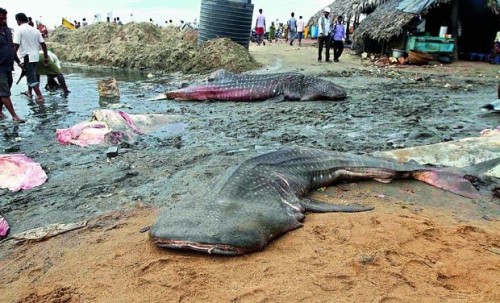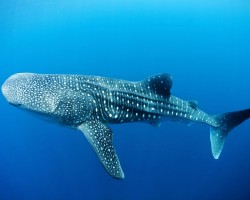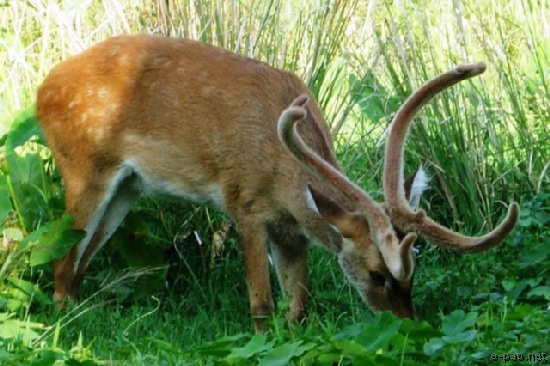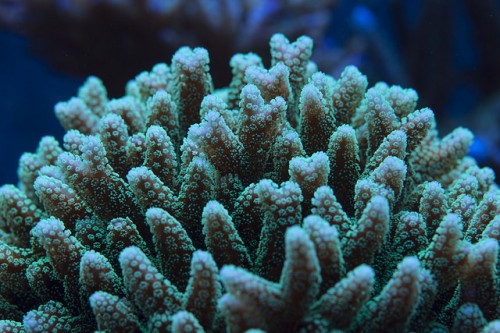The population of whale sharks in the Indian Ocean is increasing. However lack of knowledge about their importance is leading fishermen to kill them on sight or accidentally net them while fishing. As carcass of the biggest fish in the world continue to be found on the Eastern coast of the country, the count of the number of this species found dead here since 2013 has reached a whopping 71.

The Whale Shark (Rhincodon typus) is listed as Vulnerable on the IUCN Red list. It is accorded the same protection as tigers in India. The killing and illegal trading of these species is prohibited and anyone involved in the same would face seven years of imprisonment along with a heavy fine as per the Wildlife (Protection) Act, 1972.
But the eastern coast of India tell a different story. Since 2007, the sighting of whale sharks on the coasts of Vishakhapatnam and Kakinada in Andhra Pradesh has increased many folds. However, out in the open seas ignorant fisherman often find whale sharks in the same area where they’re fishing. The giant but mild-mannered fish is either killed or accidentally netted. The washed up carcasses of whale sharks along the eastern coast show how many of the fish are losing their lives while coming in search of food or breeding site on these coasts.
 Image via Deccan Chronicle
Image via Deccan Chronicle
In Search of Food
Locally known as Bogga Sora, the Whale Sharks became a common sight along the Kakinada coast post 2007.
“Whale sharks travel from the Pacific to the Indian Ocean and reach the east coast in search of food. Thanks to climate change, these species might have been finding good food here and coming over to the Kakinada coast in large numbers,” says K. Tulasi Rao, project coordinator of the East Godavari River Estuarine Ecosystem (EGREE) Foundation.
Although huge and weighing in tonnes, the whale shark feed on the smallest known creatures in the sea called zooplanktons. They use their baleen mouth to take in water and filter these minute creatures through the mouth like a sieve.
P. Sathiya Selvam, conservation biologist thinks there might be a breeding ground of the fish in the coastal waters of Andhra Pradesh based on the size of the carcass found in the past.
“We are on the job of searching if there is any breeding ground for whale sharks here. Most carcasses we found here are of baby sharks weighing between one to two tonnes.”
According to a study by the foundation launched in 2013, 71 of these creatures have been caught and killed in the fishing nets since then. Until recently whenever the fishermen unwittingly caught a Whale Shark in their net, they would consider it as a loss since the fishing net would have to be cut to release the fish. They would then cut the carcasses into pieces and retail the meat to make money.
Saving the Biggest Fish
The EGREE foundation started a movement to save the whale sharks and explained the provisions of the Wildlife Protection Act to the fishermen. This stopped the sale of the meat.
“In Gujarat, the government pays a compensation of Rs. 25,000 per shark to fishermen to buy new nets. It is encouraging to find fishermen leaving their nets in the sea and allowing sharks to live,” says Dr. Tulasi Rao.
Since after Gujarat, Andhra holds the next highest population of this rare species, the foundation is all in favour of a similar approach being adopted for their conservation here. If that is done, whale sharks can safely move in these waters.
Whale Shark – Fast Facts
- Whale Shark is the largest fish in the world and the longest ever Whale Shark found was recorded at over 13.5 metres.
- It is found throughout the world’s tropical and temperate waters around the equator between 30 and 40 degree latitude.
- It is greyish blue-black in color and covered in yellow blotches.
- It is a filter feeder and eats plankton and other small fish.
- It possesses about 300 tiny teeth in its mouth although their function is unknown to us yet.
- It is highly migratory. It has been tracked and been found to travel thousands of kilometres.
- It is a usually a solitary creature although groups of 100 or more have been sighted while feeding.
- The Whale Shark is ovoviviparous, that is the eggs hatch within the mother’s body and she gives birth to live babies.
- It has been hunted for its flesh which is very valuable in some Asian markets until 2002 when it was included on Appendix II of the Convention on International Trade in Endangered Species (CITES) .
- At places, where they regularly come close to the shore, Whale Shark watching is a major tourist attraction.
More Related Stories,
Indian Researchers Tag Biggest Fish in the World
India Ends Brutal Slicing of Shark Fins: Why it Matters






One thought on “Is India’s Eastern Coast Safe for Whale Sharks?”